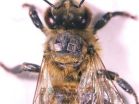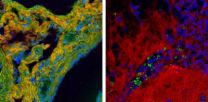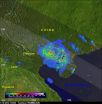(Press-News.org) CAMBRIDGE, Mass., July 22, 2014--A team of scientists has made an important discovery about the molecular interactions that occur between generally benign species of Propionibacterium bacteria and the pathogenic bacterium Staphylococcus aureus, the cause of most "staph" infections. These bacterial species are commonly found in the human nostrils and, also, on human skin. S. aureus is a potential pathogen that inhibits the nostrils of about a quarter of all adults. It is also a common cause of skin and more invasive infections. The team, led by Forsyth scientists, discovered that a small molecule secreted by skin/nostril-associated Propionibacterium species impacts the behavior of S. aureus in the lab. This research may lead to new and sustainable ways to manage the nostril-associated bacterial community to decrease infection.
S. aureus infections range in severity from mild skin infections to life threatening invasive infections. Although many people live with the bacteria in their nostrils and never get sick, having S. aureus present in the nostrils is a risk for infection. In recent years, the emergence of an antibiotic resistant form (methicillin-resistant S. aureus, or MRSA) has been a vexing problem. According to the Centers for Disease Control and Prevention, MRSA caused over 80,000 cases of invasive disease and over 10,000 annual deaths from 2005 through 2011. Community-associated or CA-MRSA imposes an annual burden of $478 million to 2.2 billion on third-party payers and $1.4-13.8 billion on society (Clinical Microbiology and Infection, June 19,2013).
In spite of the known importance of nostril colonization as a risk for S. aureus infection, little is known about the interactions between the benign bacteria that inhabit the adult nostril and S .aureus, and what might cause this bacterium to become pathogenic. In this study, the team of researchers found that a small molecule, coproporphyrin III (CIII), excreted by Propionibacterium species found on nostril and skin surfaces causes S. aureus to aggregate and stick together, i.e., form biofilms, when grown in the laboratory. CIII induction of S. aureus aggregation is dependent on dose, the bacterium's growth phase and an acidic pH in the normal range for skin surfaces. The biofilm formation occurs in the absence of plasma proteins, which suggests that it could occur on human skin surfaces, like the lining of the nostrils. "The emergence of antibiotic resistant S. aureus has accentuated the need to understand how the generally benign bacteria that live side-by-side with S. aureus might influence its ability to reside in the nose and on the skin where it has the opportunity to initiate infection," said Dr. Katherine Lemon, Associate Member of the Staff, Department of Microbiology at the Forsyth Institute. "This study is exciting because it is the first time that it's been demonstrated that there is a role for CIII in bacterial interspecies interactions and it shows that nostril microbiota are influenced by small-molecule-mediated interactions."
INFORMATION:
Overview of Study
This study, "Propionibacterium-produced Coproporphyrin III induces Staphylococcus aureus aggregation and biofilm formation," will be published in mBio on July 22, 2014. It was a collaborative, multidisciplinary effort of two research groups. The work was led by Dr. Katherine P. Lemon, Department of Microbiology, Forsyth, Cambridge, MA and members of her lab, in particular, the lead author Dr. Michael Wollenberg, along with Dr. Isabel Fernandez Escapa and Ms. Kelly Aldridge. The chemistry side was led by Dr. Michael A. Fischbach and, his postdoctoral fellow, Dr. Jan Claesen from the Department of Bioengineering and Therapeutic Sciences and the California Institute for Quantitative Biosciences at the University of California, San Francisco. In addition to overseeing her lab at Forsyth, Dr. Lemon serves on the clinical staff of the Division of Infectious Diseases at Boston Children's Hospital.
This research was supported in part by NIH through the National Institute of Dental and Craniofacial Research and the National Institute of Allergy and Infectious Diseases and through a Boston Children's Hospital Career Development Fellowship, a Fundación Ramón Areces Fellowship, a Medical Research Program Grant from the W.M. Keck Foundation, and a Fellowship for Science and Engineering from the David and Lucile Packard Foundation.
About The Forsyth Institute
The Forsyth is the only independent research institute in the U.S. specializing in oral health and related conditions. Founded in 1910, the not-for-profit organization is focused on reinventing oral and overall health through pioneering biomedical research and transformational healthcare practices. Forsyth's portfolio includes basic, translational and clinical research, an active technology transfer and corporate collaborations effort, and community programs that benefit underserved populations locally, nationally and internationally. For more information about Forsyth visit its website at http://www.forsyth.org.
Communication between nostril/skin microbiome bacteria can influence pathogen behavior
2014-07-22
ELSE PRESS RELEASES FROM THIS DATE:
Research brings us nearer to understanding how neuro cells turn cancerous
2014-07-22
Scientists from the Sloan-Kettering Institute for Cancer Research in New York with the help of Plymouth University Peninsula Schools of Medicine and Dentistry have completed research which for the first time brings us nearer to understanding how some cells in the brain and nervous system become cancerous.
The results of their study are published in the prestigious journal Cancer Cell.
The research team led by Sloan-Kettering researchers studied a tumour suppressor called Merlin.
The results of the study have identified a new mechanism whereby Merlin suppresses ...
Retail pricing strategies: Do consumers prefer deep discounts or everyday low prices?
2014-07-22
Sometimes finding the best bang for your buck feels like a wild goose chase. It's hard to know which stores offer the best prices at any given time. According to a new study in the Journal of Consumer Research, when trying to maximize savings, consumers will choose retailers they believe offer the lowest prices the majority of the time.
"We looked at the impact different pricing strategies have on the stores people shop at when they do not know the product prices unless they visit the store," write authors Shai Danziger (Tel Aviv University), Liat Hadar (IDC Herzliya), ...
Avoiding buyer's remorse: Is product satisfaction higher when consumers are flush?
2014-07-22
It's the last day of the month and your paycheck arrives tomorrow. You buy a new pair of shoes but have a nagging feeling your money could have been better spent. According to a new study in the Journal of Consumer Research, consumers are less satisfied with what they have purchased with their bottom dollar compared to when they have money in the bank.
"As someone spends money, parting with one's remaining funds makes a product feel more costly and causes consumers to be less satisfied with what they buy," write authors Robin L. Soster (University of Arkansas), Andrew ...
Report on viruses looks beyond disease
2014-07-22
In contrast to their negative reputation as disease causing agents, some viruses can perform crucial biological and evolutionary functions that help to shape the world we live in today, according to a new report by the American Academy of Microbiology.
"Viruses participate in essential Earth processes and influence all life forms on the planet, from contributing to biogeochemical cycles, shaping the atmospheric composition, and driving major speciation events," states Marilyn Roossinck of Pennsylvania State University, a member of the steering committee that helped to ...
Radio frequency ID tags on honey bees reveal hive dynamics
2014-07-22
CHAMPAIGN, Ill. — Scientists attached radio-frequency identification (RFID) tags to hundreds of individual honey bees and tracked them for several weeks. The effort yielded two discoveries: Some foraging bees are much busier than others; and if those busy bees disappear, others will take their place.
The findings are reported in the journal Animal Behaviour.
Tagging the bees revealed that about 20 percent of the foraging bees in a hive brought home more than half of the nectar and pollen gathered to feed the hive.
"We found that some bees are working very, very hard ...
Vanderbilt study shows therapeutic bacteria prevent obesity in mice
2014-07-22
A probiotic that prevents obesity could be on the horizon. Bacteria that produce a therapeutic compound in the gut inhibit weight gain, insulin resistance and other adverse effects of a high-fat diet in mice, Vanderbilt University investigators have discovered.
"Of course it's hard to speculate from mouse to human," said senior investigator Sean Davies, Ph.D., assistant professor of Pharmacology. "But essentially we've prevented most of the negative consequences of obesity in mice, even though they're eating a high-fat diet."
Regulatory issues must be addressed before ...
Enhanced NIST instrument enables high-speed chemical imaging of tissues
2014-07-22
A research team from the National Institute of Standards and Technology (NIST), working with the Cleveland Clinic, has demonstrated a dramatically improved technique for analyzing biological cells and tissues based on characteristic molecular vibration "signatures." The new NIST technique is an advanced form of the widely used spontaneous Raman spectroscopy, but one that delivers signals that are 10,000 times stronger than obtained from spontaneous Raman scattering, and 100 times stronger than obtained from comparable "coherent Raman" instruments, and uses a much larger ...
NASA's TRMM satellite measures up Super Typhoon Rammasun
2014-07-22
NASA's TRMM satellite measured up Super Typhoon Rammasun's rainfall rates, rainfall totals and cloud heights providing a look at the inner workings and aftermath of the storm.
Super Typhoon Rammasun struck the southern coast of China on Friday, July 18 as a very powerful super typhoon with sustained winds estimated at 135 knots (~155 mph or equivalent to a Category 5 hurricane on the US Saffir-Simpson scale), making it the strongest typhoon to hit the area in several decades.
Rammasun made landfall at 3:30 p.m. (local time) on Hainan Island where the southern half of ...
Preschoolers can reflect on what they don't know
2014-07-22
Contrary to previous assumptions, researchers find that preschoolers are able to gauge the strength of their memories and make decisions based on their self-assessments. The study findings are published in Psychological Science, a journal of the Association for Psychological Science.
"Previously, developmental researchers assumed that preschoolers did not introspect much on their mental states, and were not able to reflect on their own uncertainty when problem solving," says psychological scientist Emily Hembacher of the University of California, Davis, lead author of ...
Extra exercise helps depressed smokers kick the habit faster
2014-07-22
This news release is available in French. Montreal, July 22, 2014 — People diagnosed with depression need to step out for a cigarette twice as often as smokers who are not dealing with a mood disorder. And those who have the hardest time shaking off the habit may have more mental health issues than they are actually aware of.
Those insights were among the collective findings recently published in the journal Nicotine & Tobacco Research by a team of researchers based in part at Concordia University.
While nearly one in five North American adults are regular smokers, ...


